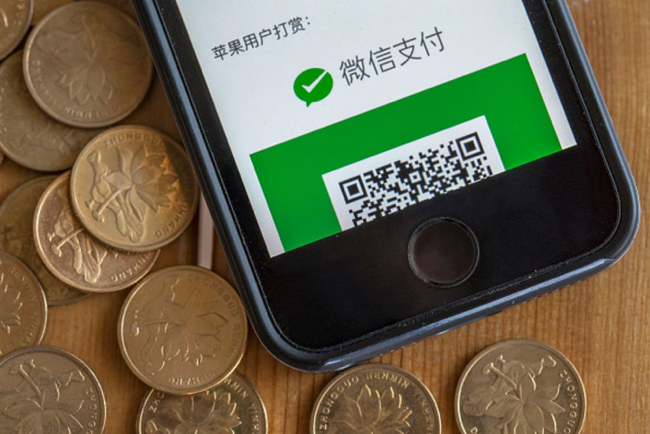By Karoline Zhao
The cashless revolution may be real.
Last month, BTCC, the biggest Bitcoin company in China, was shut down by the government. After that, China banned other domestic platforms on which virtual currencies are traded, and thus, raised the barrier for the public to buy cryptocurrencies. But the battle does not stop at these anonymous virtual payment systems, their more tangible counterpart, cash, is also at stake in China.
There is a growing trend of leaving home with nothing more than a smartphone. With this little gadget, a person has access to almost anything they need to purchase, from metrocards to booking a flight ticket. Even street food carts have succumbed to the rise of the phone. The process of paying has never been easier. This is evidenced by the fact that last year, about 660 million mobile internet users in China spent $9 trillion through their phones. And this is only expected to grow. Customers in the US, in comparison, spent a measly $112 million.
Understanding that such payments would not thrive without continued attempts to develop the internet, the latest Five-Year Plan of China, a set of economic goals signed by the Chinese Communist Party, includes aims to further speed up digital technology like 5G. Apart from the accessibility to the Internet, the low production cost of phones also makes it affordable for customers from all economic levels, thus accelerating the penetration of smartphones. These factors mentioned above fit in many countries such as the U.S and Japan, yet one third of all transactions are still done in cash in the US according to a CPO market analysis team.

When it comes to the acceptance of a cash-free society, Sweden is most akin to China. Earlier in 2016, Jon Henley from the Guardian states that only about 2% Swedish consumers pay in cash. As Business Insider points out, going cashless partly depends on citizens’ advocacy of the government and a sense of social trust. Confidence in the government as well as among individuals in Sweden and China is approximately 78%, which is 20% higher than that in America, which aligns with the rate of online payments in each country.
U.S Share of Transaction Number by Payment Instrument

Nonetheless, it turns out that this trend in China is particularly driven by two innovative applications – Alipay and Wechat – that enable users to make transactions in an incredibly convenient way. A deal is made by simply pressing “Pay” or scanning QR codes. Also, transfers are immediate between individuals without any commission fees. Apart from financial services like vendor payments and transfers between individuals, etc, Alipay also runs Taobao, the largest e-commerce company in China. Wechat, on the other hand, is the most popular messaging app adopted by people from different socioeconomic groups. Using these advantages allowed Alipay and Wechat to become two of the most dominant payment systems in China’s market, taking up 54 percent and 40 percent, respectively, according to a report from iResearch, a consulting group that focuses on China. Further, according to the prediction done by the Better Than Cash Alliance, a global promoter of digital transfers, use of cash in China will drop to about 30 percent by 2020. If mobile payments continue to grow at the rate they have been, then it’s possible that this number is an underestimation.
However, all technology can be a double-edged sword. The concern about the privacy arises as users are now susceptible to potential cyber risks. According to the executive of a cybersecurity company, there is 20-fold increases in online risk over merely four years. Often without a blink, people scan QR codes, which can turn them into easy victims for hackers looking to exploit vulnerabilities in the system. Also, by paying online, users’ personal information and shopping habits are all on the record, and such a huge database benefits merchants by allowing them to target specific customer groups. The report from Channel NewsAsia points out that Wechat can find customers for advertisers based on their database even though the company is bound by the law not to sell data. It is similar to how Facebook uses data to target advertisements. The regulations and laws in China undoubtedly can prevent illegal use of data; yet in the end, it is not guaranteed that companies in charge of data will use it in an ethical way and privacy is the price to pay.
Nonetheless, the majority of people in China clearly embrace a cash free society, as well as the government, which already plans to develop a digital RMB currency. By doing so, the Central Bank can adjust monetary policies with real-time records of transactions and data. Also, the transparency of digital currencies enables the government to keep track of all financial transactions. In this way, digital currencies are centralized, fully controlled by the authorities, which is completely opposed to the decentralized cryptocurrencies like Bitcoin. Since such currencies can be traded without any oversight, currency speculation, for which Chinese RMB is withdrawn to buy Bitcoin, became a headache of the government. The research paper, Cryptocurrencies & Capital Flight in China shows that in 2017, more than 96% of Bitcoin was bought using RMB, which indicates a huge trading volume of Bitcoin in Chinese market. The capital flight through Bitcoin worried the Chinese government so it imposed more pressure on Bitcoin exchanges to regulate trades. Yet, it also inspired the Chinese government to establish its own digital currency for surveillance as well as to combat illicit activities such as capital outflow and tax evasion. In short, though users are less and less connected to their money, the government has only extended its reach, allowing it to gain an even more complete picture of its citizens’ lives.
The battle between cash and digital currencies has begun. The disappearance of paper money may be just a matter of time, based on its status in China. Clearly, both Alipay and Wechat have ambitions to expand their influence given that they have already become acceptable modes of payment in 28 countries and 15 countries, respectively, according to the marketing executive of AliExpress in Spain. In the global context, will the Domino effect take place to respond to this wallet-free lifestyle in other countries, especially the one with so significant a size and an impact as China? Whether going cashless is just a flash in the pan or a norm in the future, time will tell.
References
- Parker, Emily. “Can China Contain Bitcoin?” MIT Technology Review, MIT Technology Review, 11 Dec. 2017, technologyreview.com/s/609320/can-china-contain-bitcoin/.
- iResearch. (n.d.). Number of mobile internet users in China from 2008 to 2018 (in millions). In Statista – The Statistics Portal. Retrieved January 31, 2018, from https://www.statista.com/statistics/265146/number-of-mobile-internet-users-in-china/.
- Upstream, M. (2018, January 18). China’s Great Leap to Wallet-Free Living | Moving Upstream. Retrieved from https://www.wsj.com/articles/chinas-great-leap-to-wallet-free-living-moving-upstream-1516294172?mod=searchresults&page=1&pos=13
- Heuermann, P. (2017, August 11). Responding to the rise of cryptocurrencies: How China is developing its own digital currency. Retrieved from https://medium.com/wonk-bridge/responding-to-the-rise-of-cryptocurrencies-how-china-is-developing-its-own-digital-currency-a51d4b4966ba
- The State of Cash: Preliminary Findings from the 2015 Diary of Consumer Payment Choice. (2016, November 03). Retrieved from https://www.frbsf.org/cash/publications/fed-notes/2016/november/state-of-cash-2015-diary-consumer-payment-choice/
- Henley, Jon. (2016, Jun 4). Sweden leads the race to become cashless society. Retrieved from https://www.theguardian.com/business/2016/jun/04/sweden-cashless-society-cards-phone-apps-leading-europe
- Weller, C. (2016, November 17). America has the technology to go cashless, but nobody trusts it enough to use it. Retrieved from http://www.businessinsider.com/america-too-paranoid-go-cashless-2016-10
- Wike, Richard. (2008, April 15). Where Trust is High, Crime and Corruption are Low. (2008, April 14). Retrieved from http://www.pewglobal.org/2008/04/15/where-trust-is-high-crime-and-corruption-are-low/
- Aldama, Z. (2017, September 10). Why China is light years ahead in the online payment revolution. Retrieved from http://www.scmp.com/magazines/post-magazine/long-reads/article/2110118/going-cash-free-why-china-light-years-ahead
- Paulo, D. A. (2017, December 04). WeChat phenomenon: How a messaging app helped spark China’s cashless revolution. Retrieved from https://www.channelnewsasia.com/news/cnainsider/wechat-china-cashless-revolution-9353998
- Tar, A. (2017, December 13). Digital Currencies vs. Cryptocurrencies, Explained. Retrieved from https://cointelegraph.com/explained/digital-currencies-vs-cryptocurrencies-explained






Leave a comment